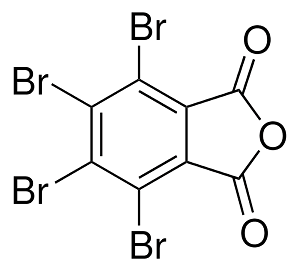HI! I’M ELEMENT AI.
Tetrabromophthalic Anhydride

Product Description
Tetrabromophthalic anhydride is a chemical compound with various industrial applications due to its unique properties.
Product:
Tetrabromophthalic Anhydride
CAS:
632-79-1
Synonym:
Bromphthal; Firemaster Pht4; 1,3-Isobenzofurandione, 4,5,6,7-tetrabromo
Structure:

Typical Characteristics
Appearance
White to light yellow powder
Density
2.87 g/cm3
Melting point
269-271 °C
Molecular Weight
463.70
Odor
Pungent odor
Purity
98%
Refractive index
1.5000
Uses, Applications & Markets
Key applications
get a quote
We Offer Tetrabromophthalic Anhydride
in various grades
A few of the grades available are listed below:



Tetrabromophthalic Anhydride used in many
industry applications
Tetrabromophthalic anhydride is a chemical compound with various industrial applications due to its unique properties. Here are some of its key uses:
- Flame Retardants: Tetrabromophthalic anhydride is commonly used as a flame retardant additive in polymers, plastics, and textiles. It helps to improve the fire resistance of these materials by slowing down or inhibiting the spread of flames.
- Epoxy Resins: It serves as a curing agent in the formulation of epoxy resins, enhancing their mechanical properties and chemical resistance. Epoxy resins containing tetrabromophthalic anhydride are utilized in coatings, adhesives, and composite materials.
- Thermosetting Resins: Tetrabromophthalic anhydride is used in the production of thermosetting resins, which are widely employed in the manufacturing of laminates, composites, and electrical insulating materials.
- Plasticizers: It can be employed as a plasticizer in certain polymer formulations to improve flexibility and processability. Tetrabromophthalic anhydride-based plasticizers find applications in PVC compounds and other thermoplastic materials.
- Textile Treatments: Tetrabromophthalic anhydride is used in the treatment of textiles and fabrics to impart flame retardant properties. Treated textiles are often used in environments where fire safety is a concern, such as in upholstery and protective clothing.
- Adhesives: It may be used as a curing agent or additive in the formulation of adhesives and sealants to improve their fire resistance and thermal stability.
- Electronic Applications: Tetrabromophthalic anhydride is utilized in the production of flame retardant materials for electronic devices and components, where fire safety is critical.
- Building Materials: It can be incorporated into construction materials, such as insulation foams, to enhance their fire resistance and meet building code requirements.
- Automotive Components: Tetrabromophthalic anhydride-containing materials are used in the automotive industry for parts requiring flame retardancy, such as interior components and wiring insulation.
- Coatings and Paints: It may be included in coatings and paints formulations to provide fire protection and improve the fire performance of painted surfaces.